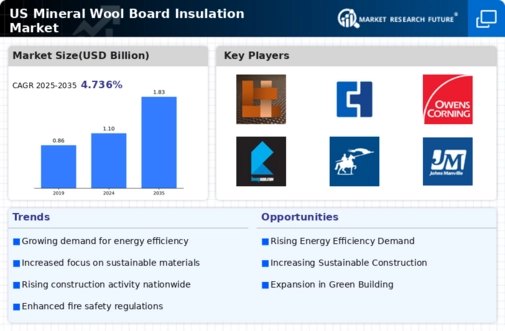The competitive landscape of the US Mineral Wool Board Insulation Market is characterized by a dynamic interplay of established manufacturers, emerging players, and strategic innovations. This market primarily revolves around the growing demand for thermal insulation products that enhance energy efficiency in buildings while meeting stringent environmental regulations. The competitive insights reflect a landscape marked by technological advancements, shifts in consumer preferences towards sustainable materials, and increasing adherence to energy efficiency standards. Companies in this sector are continually innovating their offerings while expanding their market reach to capture a larger share of the growing building and construction industry.
Understanding the competitive positioning, strengths, and market strategies of key players is essential for stakeholders to navigate this evolving market effectively.Basalt Fiber Tech has carved out a notable presence in the US Mineral Wool Board Insulation Market through its focus on innovative manufacturing processes and product quality. The company leverages its expertise in basalt fiber technology to produce high-performance insulation materials that offer excellent thermal resistance and sustainability. With a commitment to R&D, Basalt Fiber Tech is known for developing insulation solutions that are not only efficient but also environmentally friendly.
This focus on sustainability resonates well with the current market trends, as both residential and commercial sectors are increasingly prioritizing green building practices. Additionally, Basalt Fiber Tech's robust supply chain management and regional partnerships contribute to its competitive advantage, allowing for responsive service and product availability in the US market.CertainTeed stands as a prominent player in the US Mineral Wool Board Insulation Market, offering a comprehensive portfolio of insulation products designed to enhance energy efficiency and comfort in buildings.
The company’s key products in the mineral wool category include its well-regarded insulation boards which are widely used in various applications ranging from residential to commercial buildings. CertainTeed has established a strong market presence through effective branding and an extensive distribution network, making its products accessible across the US. The company continually invests in innovation, focusing on the development of products that meet the evolving needs of customers while adhering to the highest sustainability standards.
CertainTeed’s strength is further amplified by strategic mergers and acquisitions that have allowed it to expand its capabilities and product offerings, thereby reinforcing its position in the competitive landscape of the US Mineral Wool Board Insulation Market.



















Leave a Comment